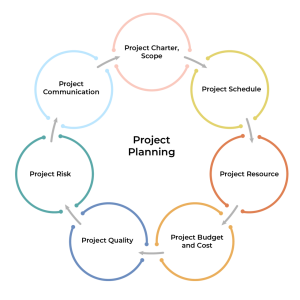
Key components of project management planning include:
Project Objectives and Scope: Clearly define the project’s goals, objectives, and expected outcomes. Identify the boundaries of the project and specify what is included and excluded (scope statement).
Project Stakeholders: Identify and engage stakeholders, including project sponsors, team members, clients, end-users, and other parties with an interest in the project’s success.
Project Deliverables: List the tangible outputs, results, or products that the project is expected to produce. Break down deliverables into manageable components.
Project Schedule: Develop a timeline that outlines the start and end dates of the project and key milestones. Use tools like Gantt charts or project scheduling software to visualize the project’s timeline.
Work Breakdown Structure (WBS): Break the project down into smaller, manageable tasks and sub-tasks. The WBS organizes work elements hierarchically to facilitate planning and resource allocation.
Resource Allocation: Identify the human, material, financial, and technological resources required for each task. Allocate resources based on their availability and expertise.
Risk Management Plan: Identify potential risks, assess their potential impact, and develop strategies to mitigate or respond to them. Anticipate challenges and establish contingency plans.
Communication Plan: Outline how communication will occur among team members, stakeholders, and project sponsors. Specify channels, frequency, and modes of communication.
Budget and Cost Management: Estimate costs associated with each project task and allocate a budget. Monitor expenses throughout the project and ensure they remain within budget.
Quality Management Plan: Define quality standards and metrics that will be used to measure and ensure the quality of project deliverables.
Procurement and Vendor Management: If the project involves purchasing goods or services, outline the procurement process, vendor selection criteria, and contract terms.
Change Management: Establish a process for handling changes to the project scope, schedule, or resources. Clearly define the steps required for approving and implementing changes.
Integration Management: Ensure that all aspects of the project are well-coordinated and integrated. Address how different project elements and phases will be managed and synchronized.
Human Resource Management: Outline roles and responsibilities for project team members, including their tasks, reporting structure, and authority levels.
Approvals and Sign-offs: Identify key decision points in the project and specify who has the authority to approve project phases, deliverables, and changes.
Documentation: Document all aspects of the project plan, including objectives, scope, schedules, resource allocations, and risk assessments. Documentation serves as a reference for the entire project team.
A well-developed project management plan serves as a comprehensive guide that helps project managers and teams navigate the challenges, complexities, and uncertainties of project execution. It fosters clear communication, efficient resource allocation, and effective problem-solving, ultimately contributing to the successful completion of the project within scope, on time, and within budget.

Key elements of project execution include:
Task Implementation: Execute the tasks and activities outlined in the project plan. Assign responsibilities, allocate resources, and ensure that each task is performed according to the schedule and quality standards.
Resource Management: Coordinate and manage human, material, financial, and technological resources to support project activities. Ensure that resources are utilized efficiently and effectively.
Communication: Maintain clear and consistent communication among team members, stakeholders, and project sponsors. Provide updates, share progress, and address any issues or concerns promptly.
Progress Monitoring: Continuously monitor the project’s progress against the established schedule and milestones. Use performance indicators and metrics to track the completion of tasks and deliverables.
Quality Assurance: Implement quality control processes to ensure that project deliverables meet the defined quality standards. Conduct inspections, reviews, and testing as necessary.
Risk Management: Monitor and address potential risks and issues that may arise during execution. Implement mitigation strategies and contingency plans to minimize the impact of risks.
Change Management: Manage changes to the project scope, schedule, or resources. Evaluate change requests, obtain necessary approvals, and implement changes while considering their impact on the project.
Problem Solving: Address challenges, conflicts, and unexpected issues that may arise. Encourage collaboration and creative problem-solving to overcome obstacles.
Vendor and Procurement Management: If the project involves external vendors or contractors, manage their performance and ensure that contractual agreements are fulfilled.
Documentation: Keep accurate records of project activities, decisions, and changes. Document lessons learned and best practices to enhance future project management efforts.
Stakeholder Engagement: Engage with stakeholders and keep them informed about project progress. Address their concerns, provide updates, and ensure their continued support.
Scope Management: Ensure that project work remains aligned with the defined scope and objectives. Avoid scope creep by carefully evaluating and controlling any changes to the project scope.
Time Management: Monitor the project schedule and take corrective actions if there are delays or schedule changes. Prioritize tasks to meet project deadlines.
Budget Management: Track project expenses and ensure that the project remains within the allocated budget. Monitor costs and adjust resource allocation as needed.
Decision Making: Make informed and timely decisions based on project data, performance metrics, and stakeholder input.
Continuous Improvement: Continuously evaluate the project’s performance and identify opportunities for improvement. Apply lessons learned to enhance future project execution.
Effective project execution requires a proactive and hands-on approach, as well as the ability to adapt to changing circumstances. Project managers and teams must work collaboratively, communicate openly, and remain focused on achieving the project’s objectives while delivering value to stakeholders.